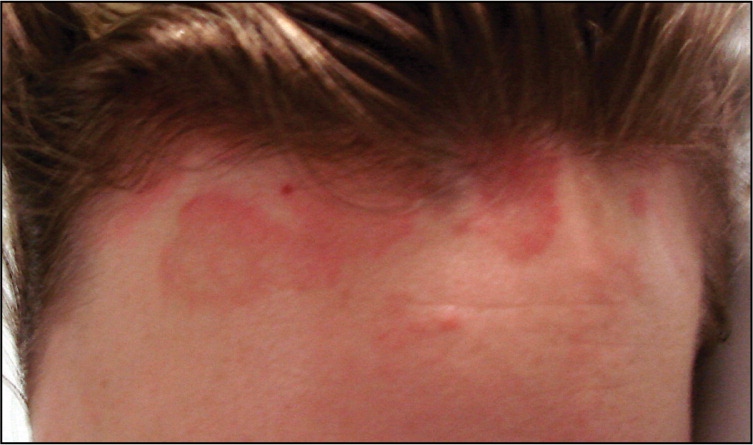
Rash and Fever in a College Student
Am Fam Physician. 2011;84(6):697-698
Author disclosure: No relevant financial affiliations to disclose.
Question
Discussion
The correct answer is B: erythema marginatum. Erythema marginatum is an evanescent, nonpruritic rash that typically occurs on the trunk and extremities, but does not usually affect the face.1 The patient's throat culture was positive for Streptococcus pyogenes, and her antistreptolysin O titers were elevated. The rash and arthralgias resolved within a few days of treatment with high-dose aspirin and penicillin.
Erythema marginatum occurs in patients who have rheumatic fever, and it is a major part of the Jones criteria for the diagnosis of rheumatic fever. Rheumatic fever can cause rheumatic heart disease and requires prompt diagnosis and treatment.2
Tinea corporis (ringworm) does not disseminate and is not associated with any systemic signs of infection. The rash typically has a fine scale and may cause alopecia. Lesions have central clearing and slightly raised borders, and are often pruritic.
Erythema migrans has a bull's-eye appearance and is a sign of Lyme disease. Like erythema marginatum, erythema migrans lesions have central clearing, but usually expand rather than migrate. Erythema migrans lesions typically have central erythema and necrosis.
Erythema multiforme is a maculopapular rash that is usually located on the palms and feet, although it can have generalized spreading. It can result from a drug reaction (e.g., sulfa, phenytoin [Dilantin], penicillins) or from viral and bacterial infections. Erythema multiforme can have a bull's-eye appearance, but it is usually pruritic and blanches away slowly.
Erythema nodosum leads to erythematous macules that are often painful. The rash most commonly occurs on the shins. There is usually no central clearing.

| Condition | Characteristics |
|---|---|
| Tinea corporis | Ringworm lesions with central clearing and slightly raised borders; often pruritic |
| Erythema marginatum | Evanescent, nonpruritic rash usually on the trunk and extremities; occurs with rheumatic fever |
| Erythema migrans | Bull's-eye appearance; central erythema and necrosis; expands rather than migrates |
| Erythema multiforme | Maculopapular rash usually on the palms and feet; often pruritic and blanches away slowly |
| Erythema nodosum | Erythematous macules usually on the shins; no central clearing; often painful |



